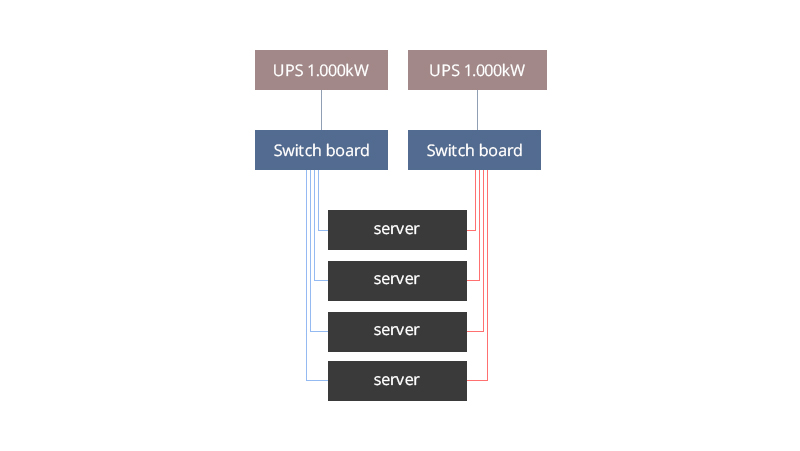Data Center UPS: Deployments & Buying Guide
Why is Data Center UPS Important?
A data center UPS (uninterruptible power supply), normally an Online Double-Conversion UPS, is a very important device to deliver a dependable supply voltage using a power source (generally battery) for a momentary period. Any power failure can have a devastating impact on mission-critical computers, communications and data, resulting in costly downtime. A UPS facilitates hardware protection, protects data from losing and corruption and offers continuity of service.
How to Deploy Data Center UPS?
In order to meet the high uptime requirements for data centers, UPS systems are often deployed with redundancy. There are three main UPS redundancy architectures, N+1, 2N and 2(N+1). N is the full UPS capacity required to handle the total load. In other words, N is the same as non-redundant.
N+1 UPS Redundancy
N+1 UPS deployment provides minimal reliability by adding a component to support a single failure or requirement of that component. Here is an example to understand N+1 UPS deployment better. Imagine you need to buy 35 bananas for 35 school children in one class and want to buy an extra one in case of unexpected shortage. The “N” would represent the exact number of bananas you need (35) and the extra one banana is the “+1”. Similarly, in an N+1 UPS redundancy system, if the total data center load is 1,000 kW and each UPS platform can handle 500 kW, three data center UPS of 500 kW are needed (N=1,000 kW; N+1=1,500 kW).

2N UPS Redundancy
2N UPS redundancy equates to fully redundant data center architecture separated in two sides (side A and side B), or mirrored systems. If two UPS(s) are required, there would be completely diverse and independent two UPS(s) for resiliency. In a 2N UPS redundancy, each side would be able to handle 100% load capacity.

2(N+1) UPS Redundancy
2(N+1) UPS redundancy offers the highest reliability among the three in data centers. It is actually the double amount capacity needed plus an extra capacity or a redundant N+1 system. This level of redundancy can tolerate multiple component failures or can maintain N+1 redundancy with an entire system down. Since it is the highest level of UPS redundancy among N+1, 2N and 2(N+1), 2(N+1) architecture always costs more no matter in initial component costs or operating costs.
Factors to Consider When Buying Data Center UPS
Listed below are ten main factors one should take into consideration when buying a data center UPS.
-
UPS size: UPS systems come in a variety of sizes and form factors such as desktop models, tower models and rack-mount models. Desktop models are compact to fit on a desk. Tower models stand upright on the ground or on a desk/shelf. Rack-mount models are typically used in server and networking applications. For more details, refer to different types of UPS.
-
UPS capacity: Measured in “watts”, the UPS capacity is how much power a UPS system can provide. The higher the capacity, the more electronic equipment or devices it can support. One should calculate the load (combined amount of power of multiple devices) and then choose a proper UPS. Normally, one should choose a UPS with an output watt capacity 20-25% higher than the total wattage of the devices needed to connect, which helps the UPS deal with fluctuations in power demand, leave margin for other equipment, and reduce the chance of overload. For more details, refer to How to Figure Out the Required UPS Capacity?
-
Backup runtime: Runtime is how long a UPS system can support the attached devices with electricity during a blackout. A UPS which accepts external battery packs can be used to extend runtime during a blackout. The smaller the wattage load connected, the longer the batteries will work. The larger the wattage load, the shorter the runtime will be.
-
Power source voltage: Be sure that the UPS input plug/connector matches the receptacles of the input power source. For example, in North America, the voltage used to power servers and networking equipment is typically 120 V or 208/240 V. Europe and Asia typically provide 230V power.
-
Number of receptacles: Make sure there are more outlets/receptacles than the number needed at present to ensure room for future growth.
-
Data line surge protection: Select UPS models with RJ11 jacks, RJ45 jacks or coaxial connectors to protect equipment against surges on connected phone, network or coaxial lines.
-
Pure sine wave output: Utility power supplies electricity in the form of sine wave alternating current. When the UPS is in normal mode, it passes the same electrical sine wave to your connected devices. If the UPS switches to operate in battery mode, it either produces sine wave or simulated sine wave electricity to power your electronics. Pure sine wave power is required by some devices, such as computers with active Power Factor Correction (PFC) power supplies. Determine whether to buy an UPS with pure sine wave output or not according to real needs.
-
LCD control panel: Normally, UPS with LCD interface is recommended. It can display helpful information like voltage, frequency, backup time and so on, offering an intuitive view of the UPS status and making it easier for system management.
-
Fault indicator: The LED indicators inform users of potentially dangerous wiring problems in wall circuits.
-
Intelligent slot/SmartSlot: An intelligent slot can customize UPS capabilities with network management cards. The optional network card allows comprehensive management via SNMP, Web, SSH, or telnet. To remotely monitor energy usage and reboot unresponsive equipment from anywhere, an intelligent slot is important for UPS in data centers.
You might be interested in
Email Address

-
PoE vs PoE+ vs PoE++ Switch: How to Choose?
Mar 16, 2023














